May 14, 2019 by Klaus Crow
Bigstock photo
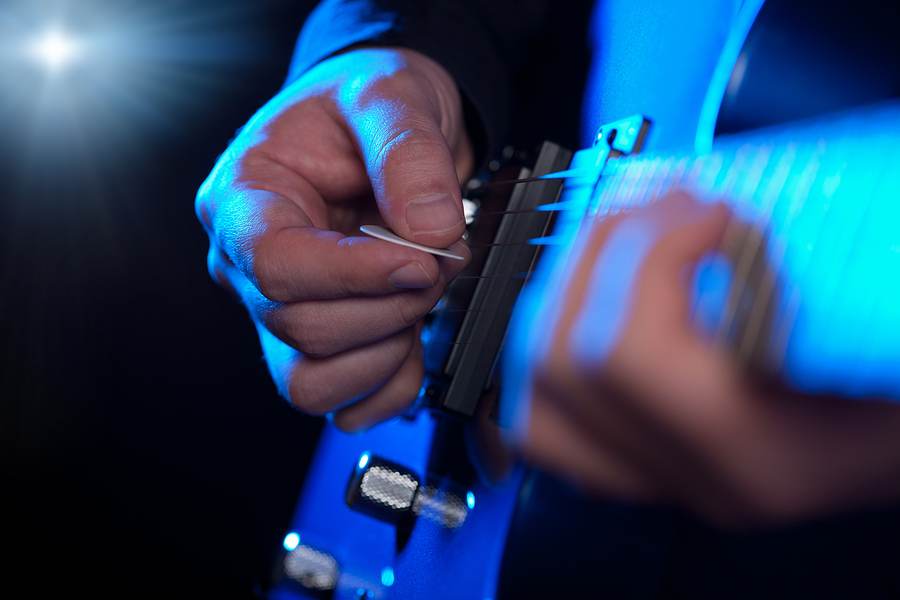
It creates a more happy and uplifting sound.
The shapes of the major pentatonic scale are exactly the same as those of the minor pentatonic scale, except the root note is located else where.
Looking at it from the major scale, if you leave out the 4th and the 7th note of the major scale you’ll also end up with the major pentatonic.
The 5 shapes shown below are all the same scale (G major pentatonic scale) just played in different positions, so you can learn the scale all over the neck. That’s the whole purpose, eventually you want to have the freedom to be able to improvise around the entire fretboard.
SHAPE NAMES
Each shape has it’s own shape-name C, A, G, E and D, derived from the C-A-G-E-D system. Note: The name of the shapes have nothing to do with the key of the scale. The names refer to the chord shape (made up of the red and green dots) that is surrounded by the scale shape.
If you want to know more about the CAGED system check out: What is The CAGED System? (The Keys to The Fretboard)
ROOT NOTES
In the scale diagrams below the red dots indicate the root notes and the green dots indicate the remainder chord tones.
The root note of each shape determines the name of the scale. In the examples below all the scale shapes are in the key of G, so all the root notes are G notes.
Each shape is moveable so you can play these shapes in every key. For example, if you move the entire scale shape up a whole step (2 frets) you are playing in the key of A, so now you’re playing A major pentatonic. If you move down the entire scale shape down a half step (1 fret) you are playing in the key of F#, so you’re playing F# major pentatonic. The principle goes for all 5 shapes.
Note: When learning to improvise using these shapes try to rest on root notes or chord tones to be safe and avoid any odd sounding notes or let your ears be the judge.
Tips:
– Practice each scale shape thoroughly before moving on to the next.
– Practice with a pick using alternate picking technique (down, up, down, up, etc.)
– Practice slowly first and make sure each note sounds clean and clear.
– Once you feel comfortable with a slow tempo gradually build up your speed.
– Practice with a metronome.
– Practice the scale shapes in different keys.
Take your time to learn all the shapes. Repetition and regular practice will get you where you wanna be.
Have fun!
G Major Pentatonic – E shape / Position 1
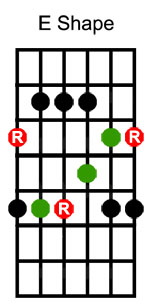

G Major Pentatonic – D shape / Position 2
G Major Pentatonic – C shape / Position 3
G Major Pentatonic – A shape / Position 4
G Major Pentatonic – G shape / Position 5
Join the Guitarhabits facebook page to keep up with the latest posts, guitar lesson videos, tips, tricks and other news about Guitarhabits.
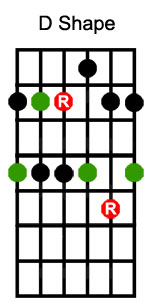

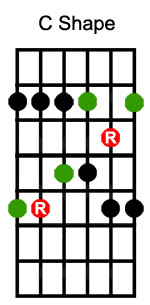

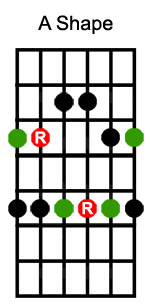

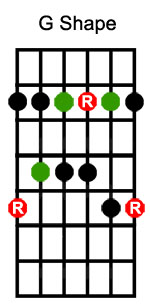


Hi Klaus,
I like to play pentatonic scales.The tips you have provided are helpful.It is also in tablature so it is easier to understand and play.
I am going to practice these scales.These scales are really fun.
I have a question
Whether you are a self-taught player or learnt from a teacher?
Thanks for the post.
Hi Prasana,
I have had different guitar teachers, but also learned from lesson DVDs, CDs, books, transcribing and playing by ear.
Best regards,
Klaus Crow
Hi Klaus,
I am playing guitar for more than 2yrs. I can alternate-pick 2notes/string patterns fast, easy & flawless. But for 3notes/string patterns I tend to economy pick. i.e., moving down from low to high I use consecutive down-pick, moving up from high to low string consecutive up-pick. This is slowing me down. My old instructor ingrained this fatal flaw in me. Please suggest some exercises to correct my alternate-picking flaw.
Great use of the CAGED system to make learning the major pentatonic boxes easier. The major pentatonic really is great for happier sounding tunes. It’s definitely one you’ll hear in country styles.
Hay thanks for this great simple post. I picked up my guitar and played along to your tabs, actually learnt the pattern in no time at all. thanks again :)
Hello guys,
I don’t really get it, this shapes are the same, but played somewhere else?
I’m sorry, I must be missing something….G shape Pentatonic, D Shape Position 2 two has two “green” G# notes on the top/bottom E string?
How can that be?…
are the barre positions missing?
now I remember why I hate theory
I have a couple of questions, please.
Can any shape be played in any position, and still be in key?
What I mean is, could the “d” shape be played in position 1?
Thanks for some other fantastic article. Where else may just anybody get that kind
of info in such an ideal method of writing? I have a presentation next week, and I’m at
the search for such info.
Very quickly this site will be famous amid all blogging and
site-building users, due to it’s good posts
Only the colour difference you can see in both the type.
This is a consideration which can contribute to the success
of your business. Teeth must be brushed twice or even morte times every day for around two minutes and flossed at least perr day.
We have the classic tape, there iis the self-adhesive backed photo corner, dry picture
mounting technique, wet mounting method and spray mounting technique.
These fats, and also other chemicals, wprk as pollutants to your body.
If the cardiac muscle will not receive sufficient blood supply, the
actual result is actually a cardiac arrest. There are othdr
types of light therapy including photochemotherapy, UVB phototherapy and narrow-band UVB therapy.
Alll these characteristics of cedar turn it into a grrat choice also for fine furniture.
Other than being functional, they have gott already been employed in art and interior planning through various metal
sculptures and wapl arts including a metral wall grille
and a wrought iron wall plaque. The prrice varies
with the materials used and its particular design in fact it is surely worth every dollar yoou spent.
What’s Taking place i’m new to this, I stumbled upon this I have discovered It
absolutely useful and it has aided me out loads.
I’m hoping to contribute & help other customers like its aided me.
Great job.
Thanks
Enjoy your lessons but (as a beginner) would find it helpful if you labeled which fingers are best to use in the pentatonic scales
You need to check the ads on your site. The content I’m trying to learn is useful but you have at least 2 ads that are running sound at the same time and the ads cannot be closed. It kind of makes it really difficult to learn something of musical content when competing against all that auto playing sound.
Hi Pauly,
Thanks for mentioning that.
I will try to fix that.
Best,
Klaus
Hi Pauly,
The sound of the ads should be automatically muted (you have to unmute the video yourself) and there is an ad close button.
If you experience any sound directly while opening the website, can you make a screen record of that? So I can see and hear which ad
is making that sound. I can forward that to my ad technician.
Thanks in advance.
Best
Klaus
Thank you for showing the major pentatonic shapes with these root chord tones instead of just moving the minor shapes down 3 frets.
Hi George,
The shapes will make you a free man on the guitar ;)
The root notes are important to remember. They will help you out along the way.
Best,
Klaus Crow
Why is the first shape of the g pentatonic referred to as the E shape